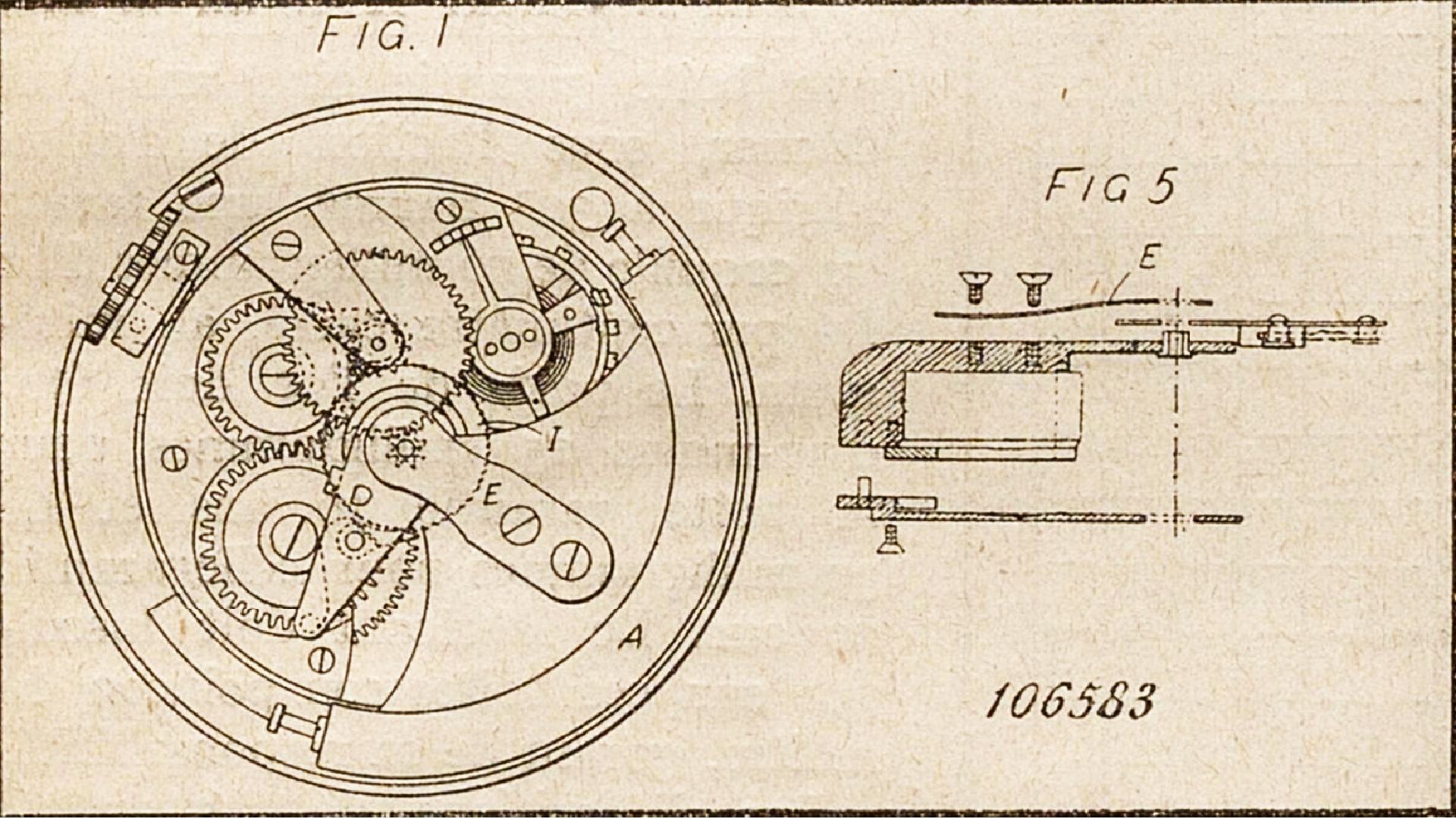Join CHRONOHOLIC today!
All the watch news, reviews, videos you want, brought to you from fellow collectors
All the watch news, reviews, videos you want, brought to you from fellow collectors
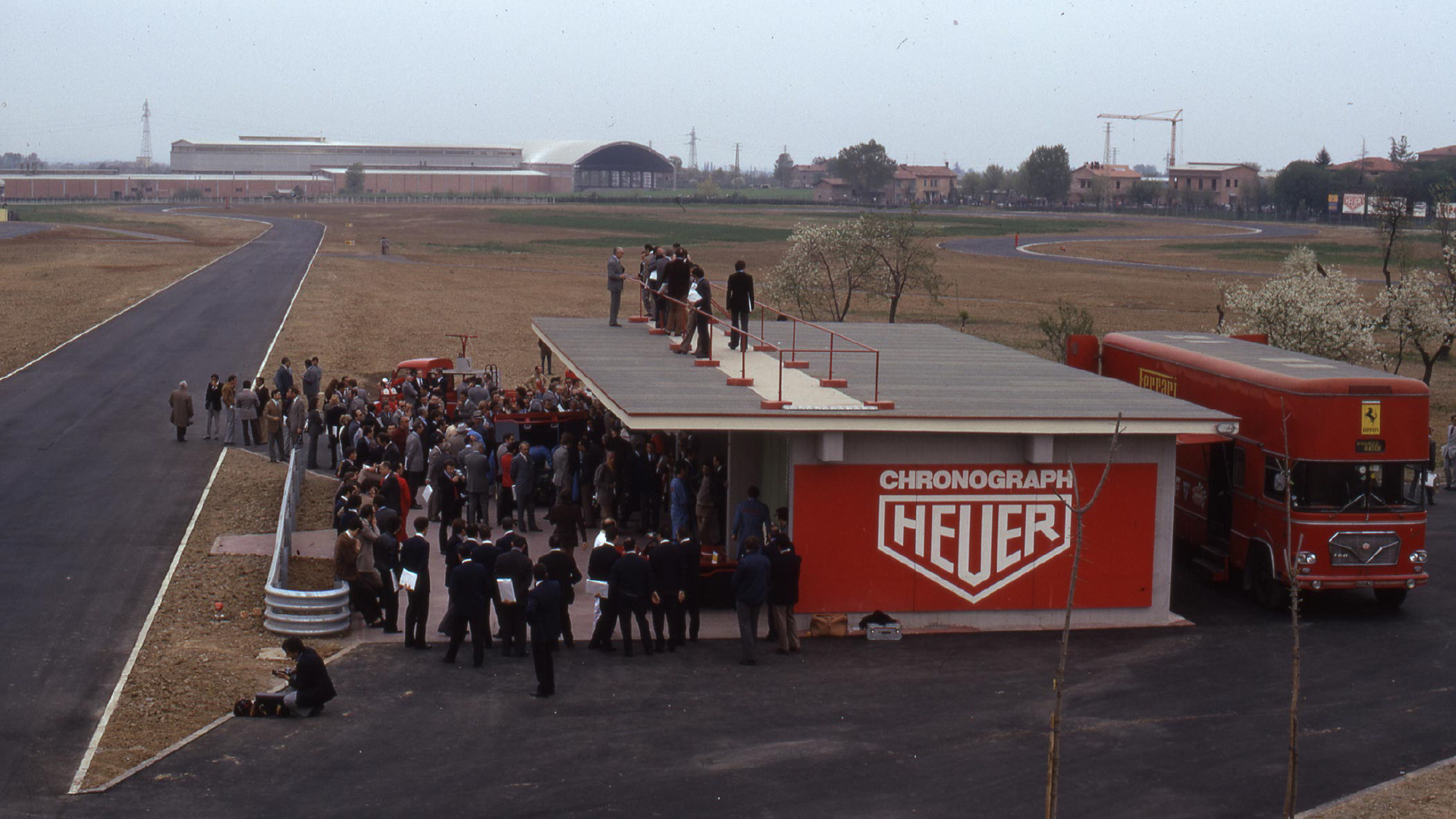
%20(1).jpeg)
%20(1).jpeg)
Every once in a while, a designer comes along who doesn’t just make products — he shapes an era. Jack Heuer is that designer for the world of watches.
A century after the company was founded by his great-grandfather, Jack Heuer’s vision carried the family name beyond Switzerland’s borders and onto the wrists of drivers, collectors, and film stars. His instinct for design and his appetite for the new ensured that Heuer — later TAG Heuer — became more than a watch brand; it became a cultural symbol.
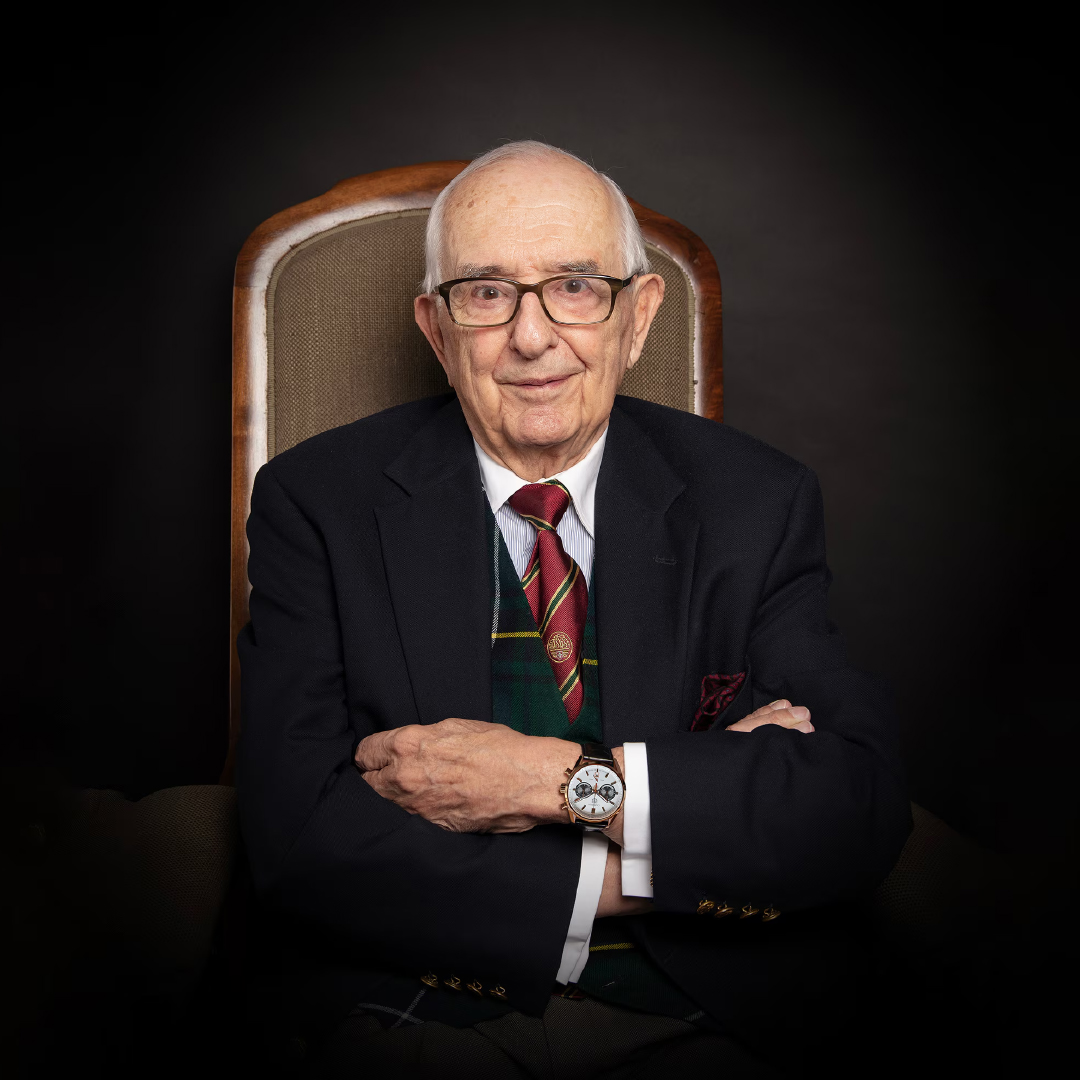
Jack Heuer understood what few did — that a watch isn’t merely a tool to measure time, but a way to feel it. Every watch he designed pushed boundaries in form and function, yet remained unmistakably Heuer. His introduction of modular construction, microrotor architecture, and racing-inspired ergonomics redefined how watches interacted with their wearers.
To collectors today, that balance between daring and discipline defines not just the man, but the legend.
1962 – Autavia: The Beginning of a New Era
When Jack Heuer took charge of the company at the age of 29, his first mission was to modernize its image. The result was the Autavia, the first wrist chronograph designed entirely under his leadership.
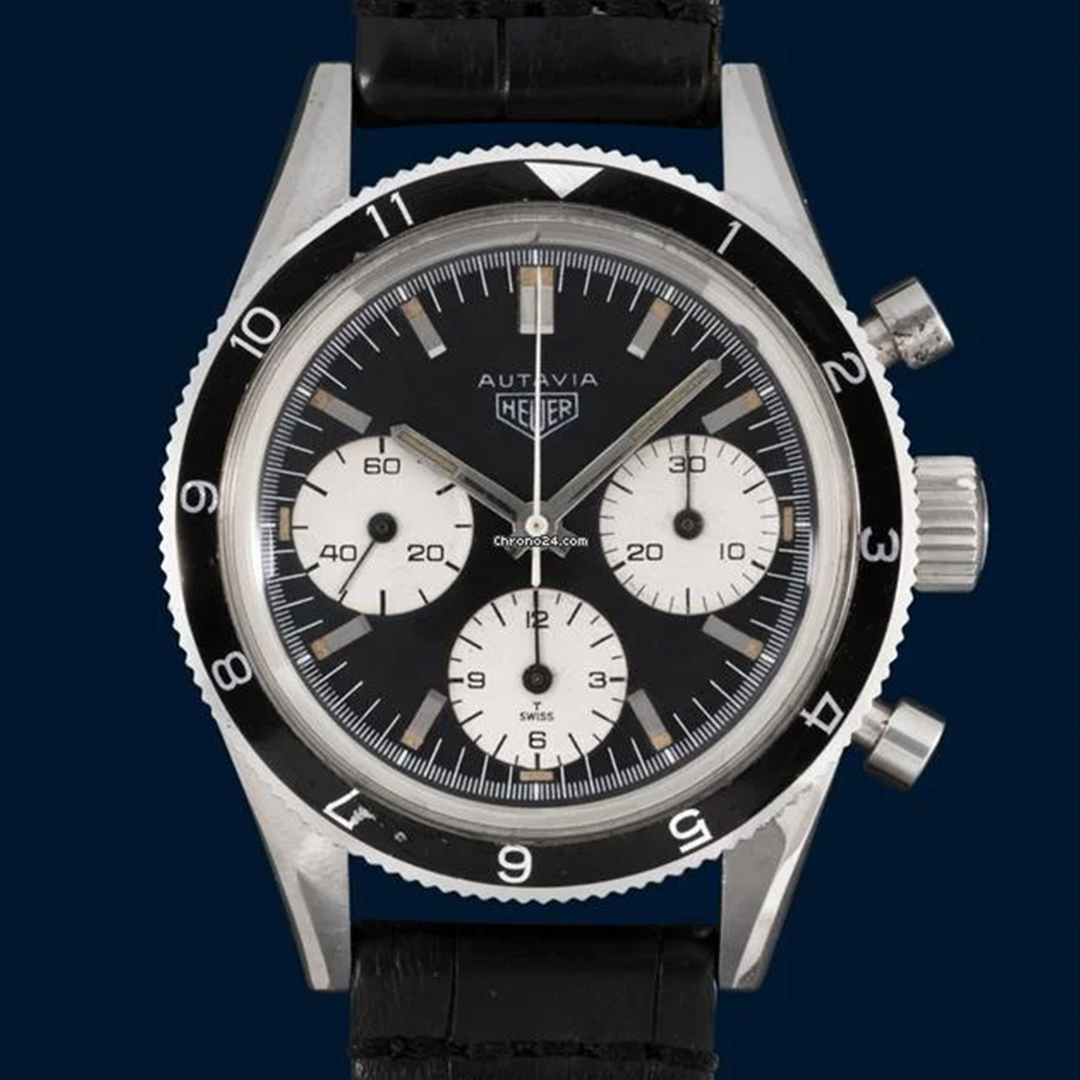
Originally a dashboard timer used in rally cars and aircraft, the 1962 wrist version featured a stainless steel 39mm case, a rotating aluminum bezel available in 12-hour, minute, or tachymeter scales, and the Valjoux 72 hand-wound chronograph movement beating at 18,000 vibrations per hour. Its large luminous dauphine hands, contrasting sub-dials, and highly legible black-and-white layout gave it the functionality racers demanded.
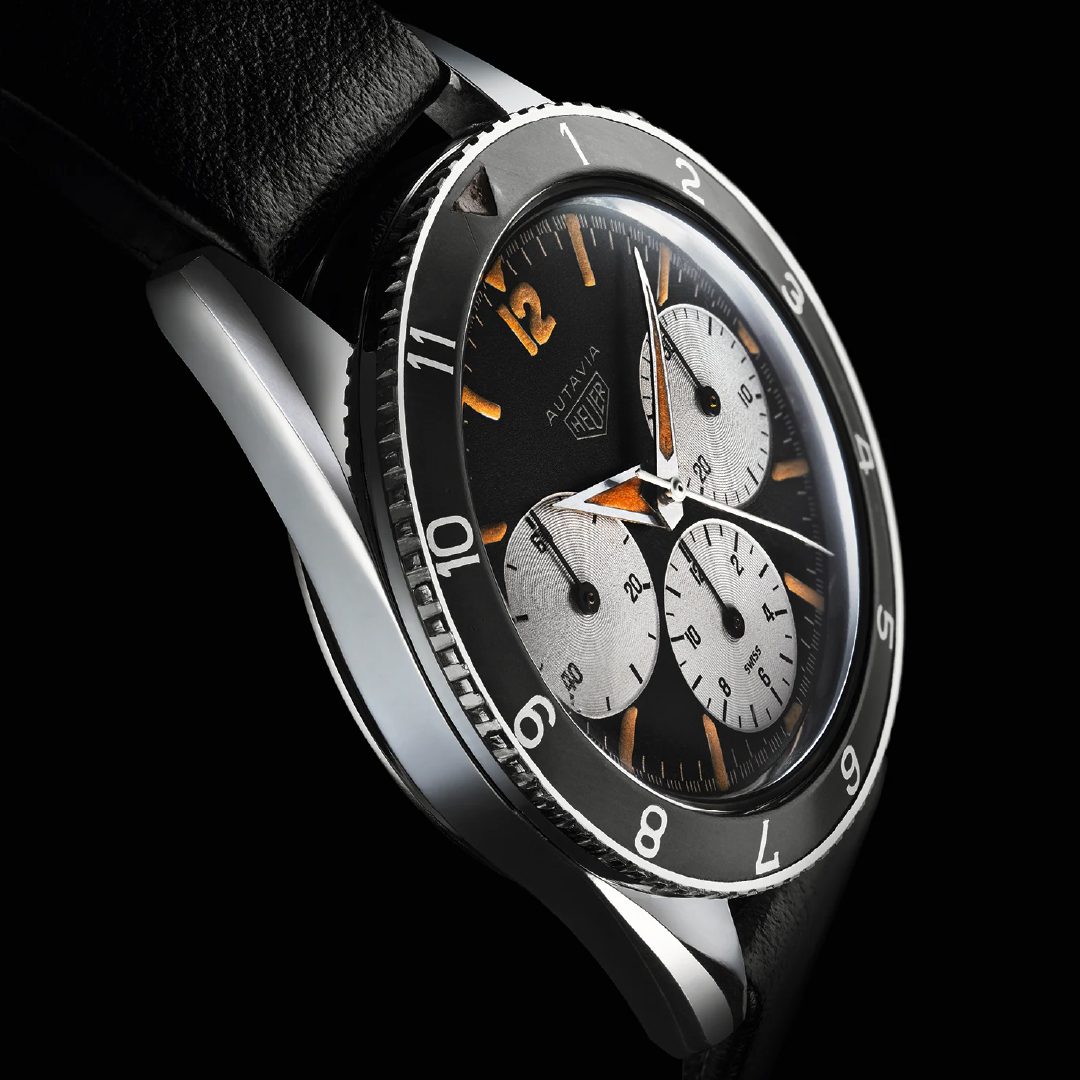
Heuer Carrera, Reference 2446, circa 1962
As described by Jack Heuer in his autobiography,
“In the autumn of 1961 I decided with my production team to create a new “Autavia” as a wrist chronograph. Until then we had never added a turning bezel to one of our wrist chronographs. We therefore designed this new “Autavia” to have a turning black bezel with a choice of division markers. A bezel with 60 separate one-minute divisions, for example, would allow the wearer to set a marker for a defined interval of less than one hour; a 12-hour division would allow the time in another time zone to be displayed; and divisions of 1/100th of a minute would be useful for time study purposes.”
The case uses a screw-back construction, with the back marked with the “Heuer” shield and “Autavia” name, as well as “Waterproof – Guaranteed 330 Feet Under Water”.
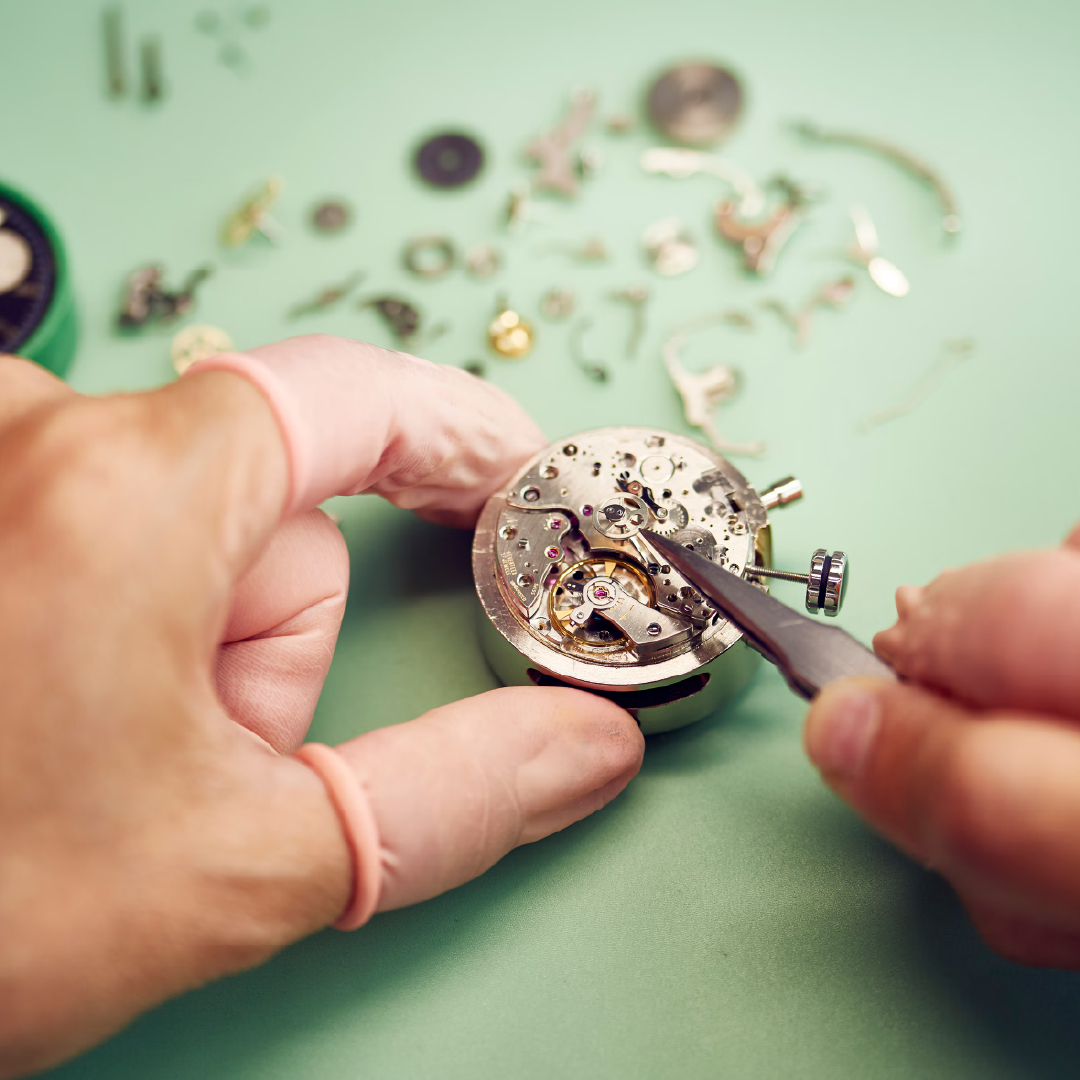
The first generation of the Autavia chronograph (1962 through 1967) used round, screw-back cases, with manual winding movements. The second generation (1967 through 1972) used a snap-back case referred to as a “compressor” case, with manual winding movements. The third generation of Autavia chronographs (1969 through 1983) used C-shape cases, with a variety of automatic and manual winding movements.
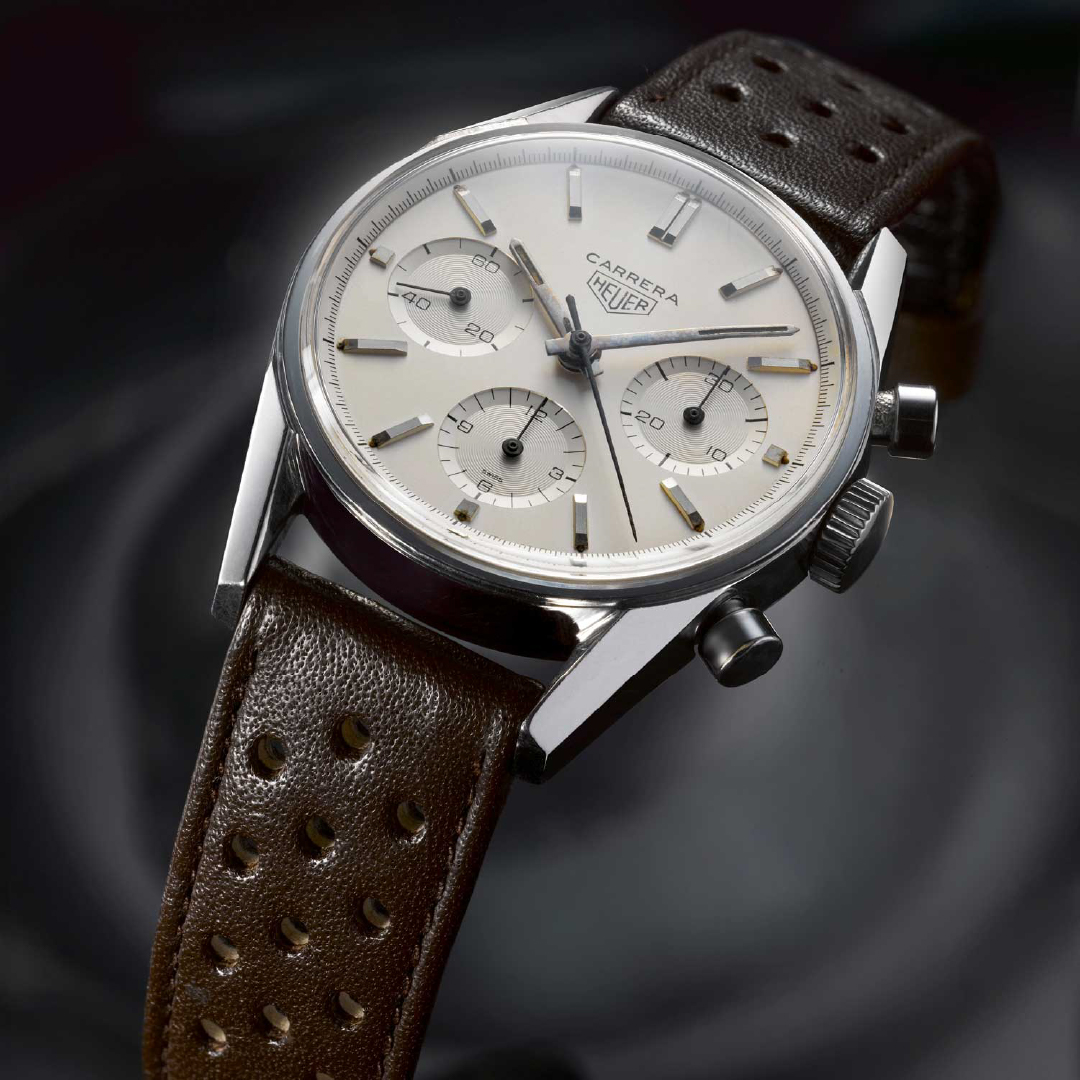
Heuer Autavia, Reference 1163T, circa 1972
The Autavia wasn’t just a new watch — it was a statement that Heuer would lead the age of motor sport timing.
1963 – Carrera: The Chronograph as Art
The story of the TAG Heuer Carrera is inseparable from the legacy of TAG Heuer itself.
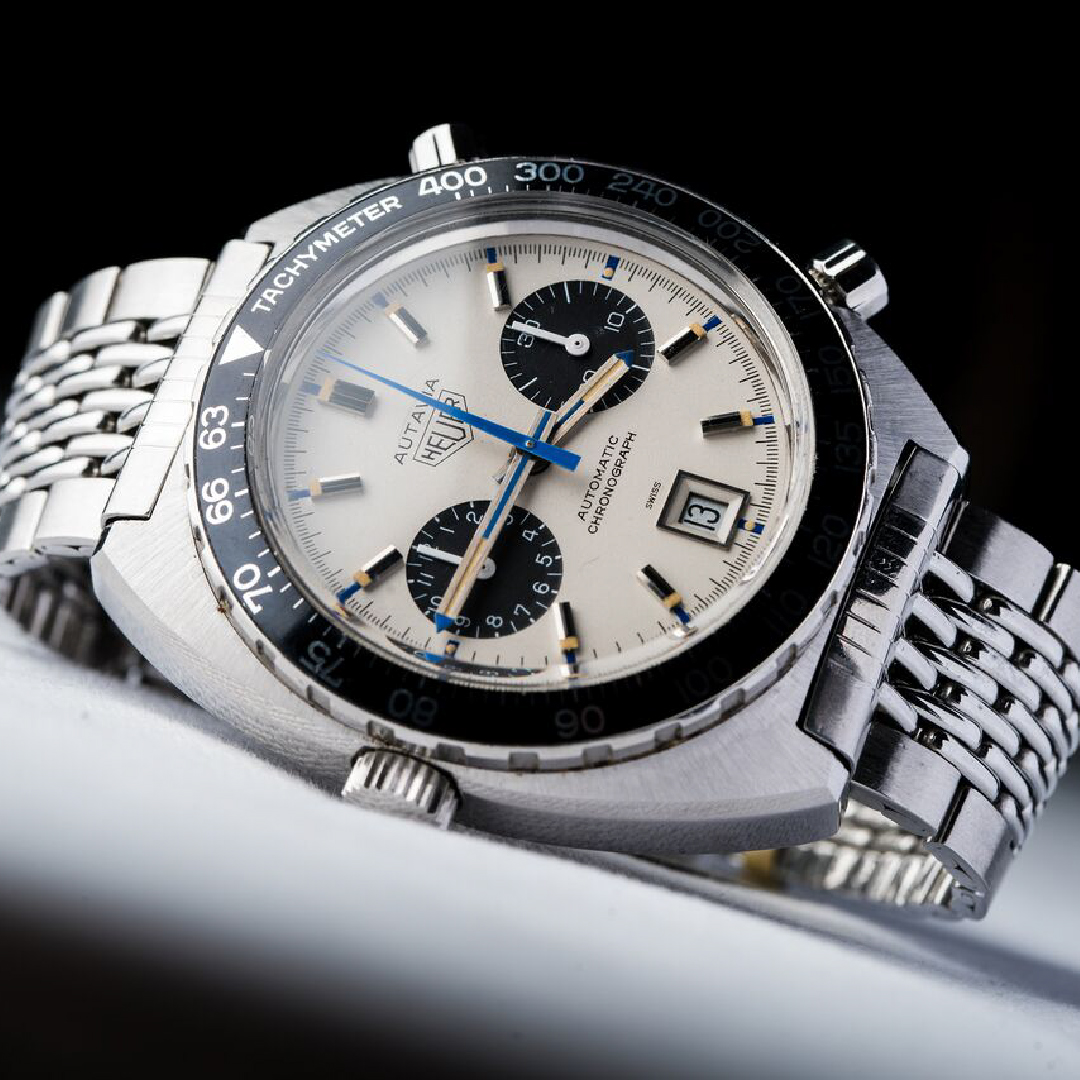
Heuer Carrera, Reference 2447S, circa 1963
Even its origin has an iconic story. It all began in 1962, when Jack Heuer attended the 12 Hours of Sebring in Florida. There, he heard talk of the Carrera Panamericana — a legendary and perilous Mexican road race from the 1950s. The name Carrera, meaning “race” in Spanish, struck him instantly — elegant, dynamic, and full of spirit. When he returned to Switzerland, he wasted no time registering the name Heuer Carrera. The rest, as they say, is history.
Decades later, Heuer would share his thoughts on the Carrera name in his autobiography.
“I loved not only its sexy sound but also its multiple meanings – which include road, race, course and career. All very much Heuer territory.”

Jack Heuer with his father Charles Edouard Heuer
Powered initially by the Valjoux 72 and later the Valjoux 92, the Carrera featured a 36mm polished stainless-steel case, a flat silver or panda dial, and a clean tri-compax layout free of tachymeter clutter. Its inner tension ring, set at a 45° angle, not only increased structural rigidity but served as a perfect platform for a sharply printed seconds scale — improving legibility under race conditions. The double-step bezel, faceted lugs, and sunray-brushed dial finish gave it visual precision to match its mechanical reliability.
As Heuer once declared,
‘The Carrera exudes modernity and elegance thanks to its clean, ultra-legible design. This timeless style, as well as its bold and daring spirit, have been the keys to its longevity’.
In the decades since the TAG Heuer Carrera has evolved into a vast collection featuring an expansive variety of functions, movements, materials, and designs.
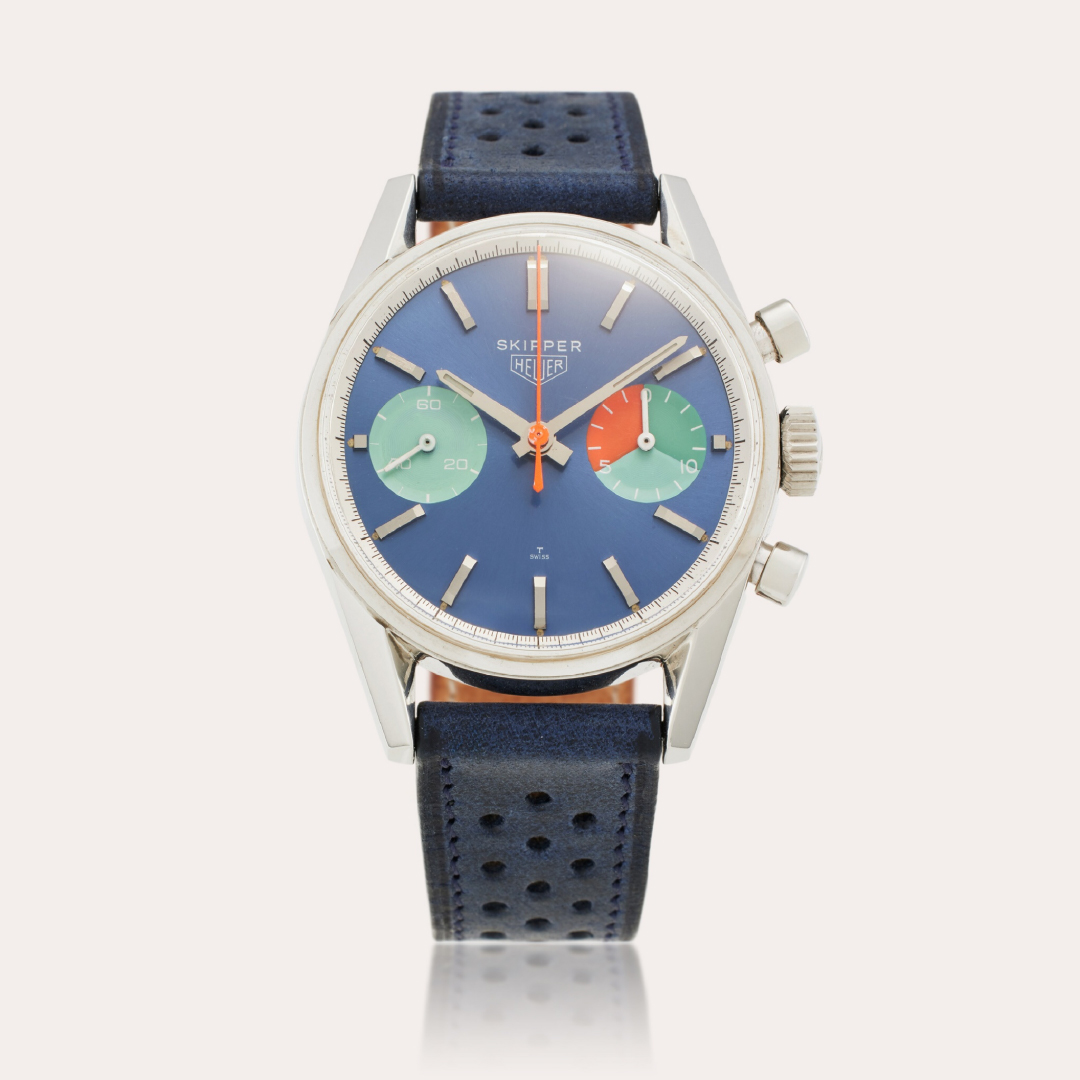
Heuer Skipper 7754, circa 1968
In 1968, Heuer introduced the Skipper, a colorful yachting chronograph with a 15-minute regatta countdown, celebrating the brand’s involvement with the America’s Cup.
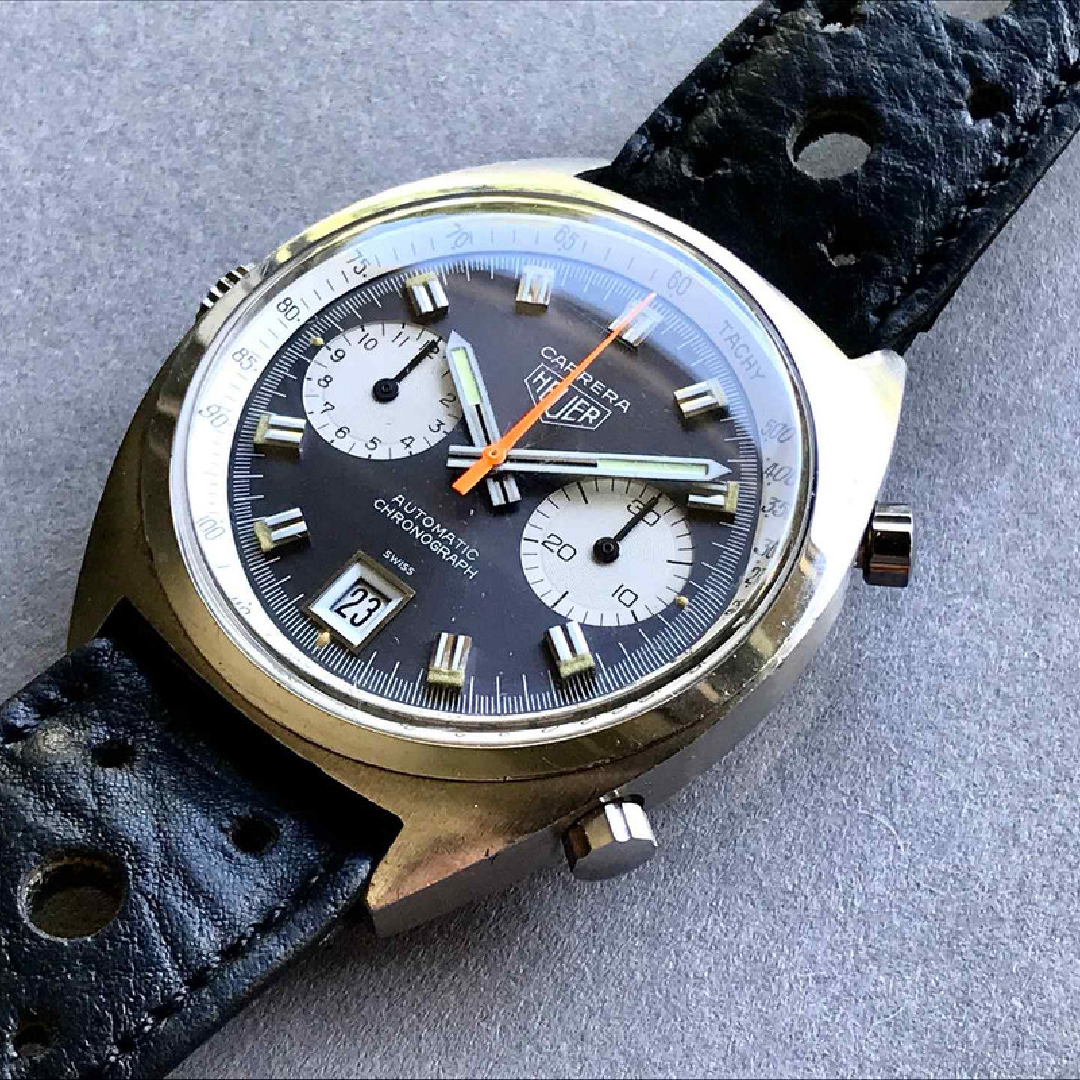
Heuer Carrera Chronomatic, Reference 1153N
By 1969, the first automatic Carrera arrived, powered by the revolutionary modular Calibre 11, combining self-winding mechanics with Jack Heuer’s minimalist dial philosophy. The modular design reduced movement thickness while maintaining automatic winding efficiency, enabling the Carrera to retain its slim, elegant profile.
The Carrera was reinvigorated in 1996 with a reissue that appealed to collectors, followed in 2012 by the Mikrogirder, a gravity-defying mechanical chronograph, achieving a staggering 7,200,000 vibrations per hour, unprecedented in mechanical watchmaking, accurate to 5/10,000th of a second.
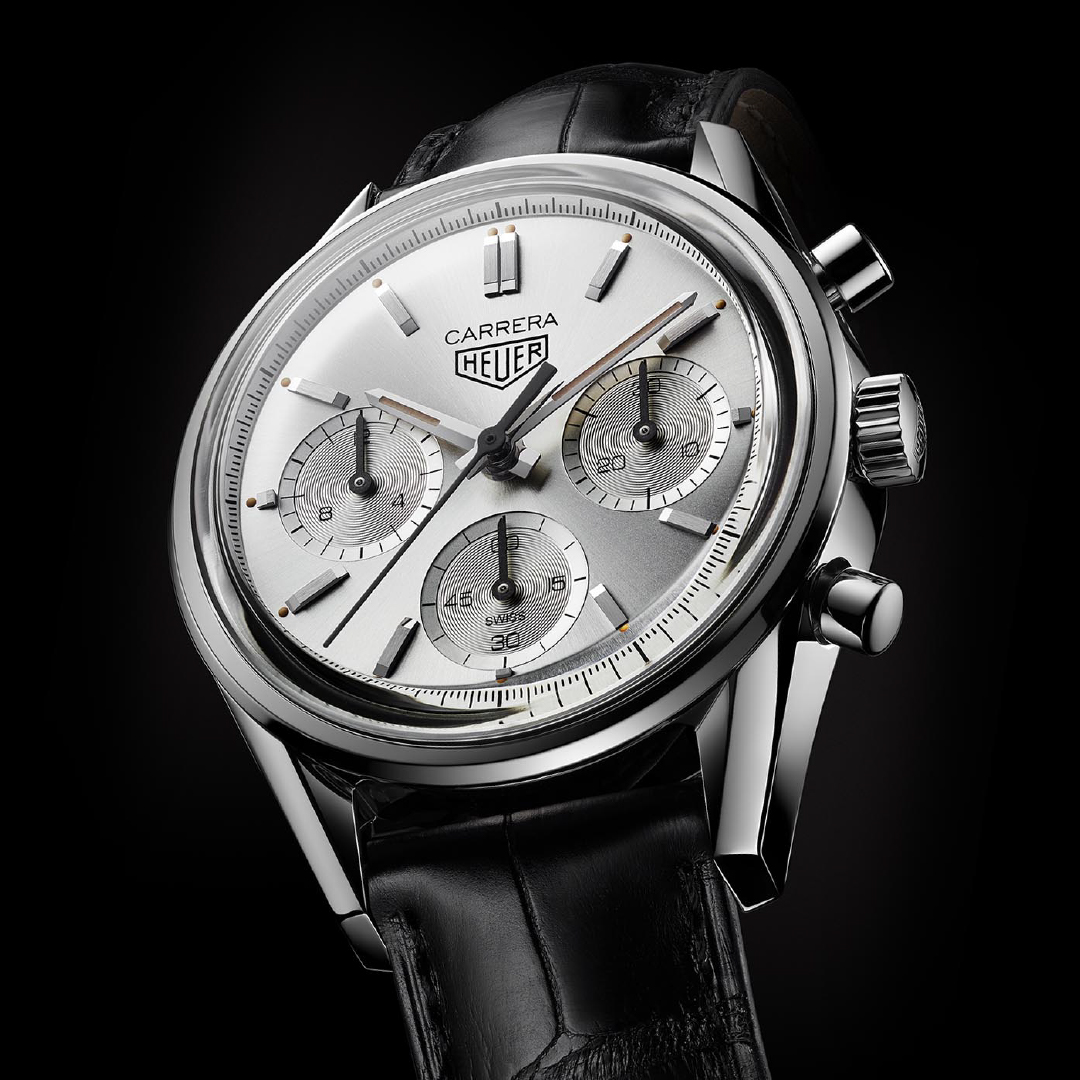
TAG Heuer Carrera 160 Years Anniversary Limited Edition, Reference CBK221B.FC6479
Most recently, the 2020 160th Anniversary Carrera Sport Chronograph and Silver Edition showcased the in-house Calibre Heuer 02, blending heritage design cues with contemporary watchmaking technology.
1969 – Monaco: The Shape of Modern Time
In March 1969, Heuer unveiled the Monaco reference 1133 as part of the coordinated launch of the Calibre 11 automatic chronograph. Calibre 11 was the result of Project 99, a joint venture with Breitling, Büren, and Dubois Dépraz, which produced the self-winding chronograph just months after Zenith’s El Primero.
With its radical square case and bright blue dial, the Monaco was unlike anything else on the market.
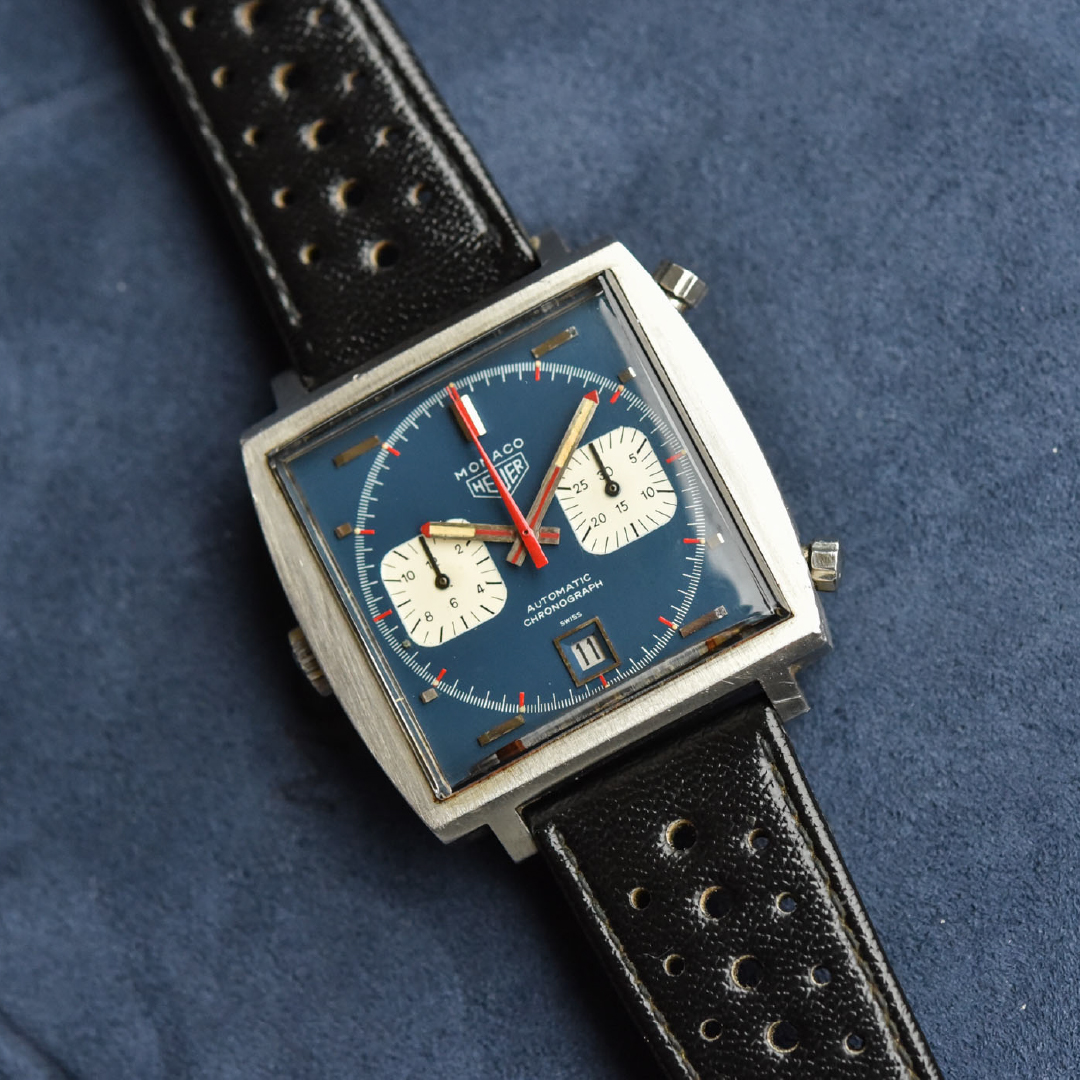
Heuer Monaco, Reference 1133B, circa 1969
With its bold 39 mm square case, sharply cut lines, and a play of brushed and polished finishes, the Monaco made an immediate statement at Basel in 1969. The unconventional left-hand crown subtly signaled a new era — manual winding was no longer necessary. Inside, the watch housed the revolutionary Calibre 11 automatic chronograph, one of the world’s first modular self-winding movements, marrying Büren’s 1282 microrotor base with a Dubois Dépraz chronograph module. Beating at 19,800 vph and offering a 42-hour power reserve, it balanced innovation with performance.
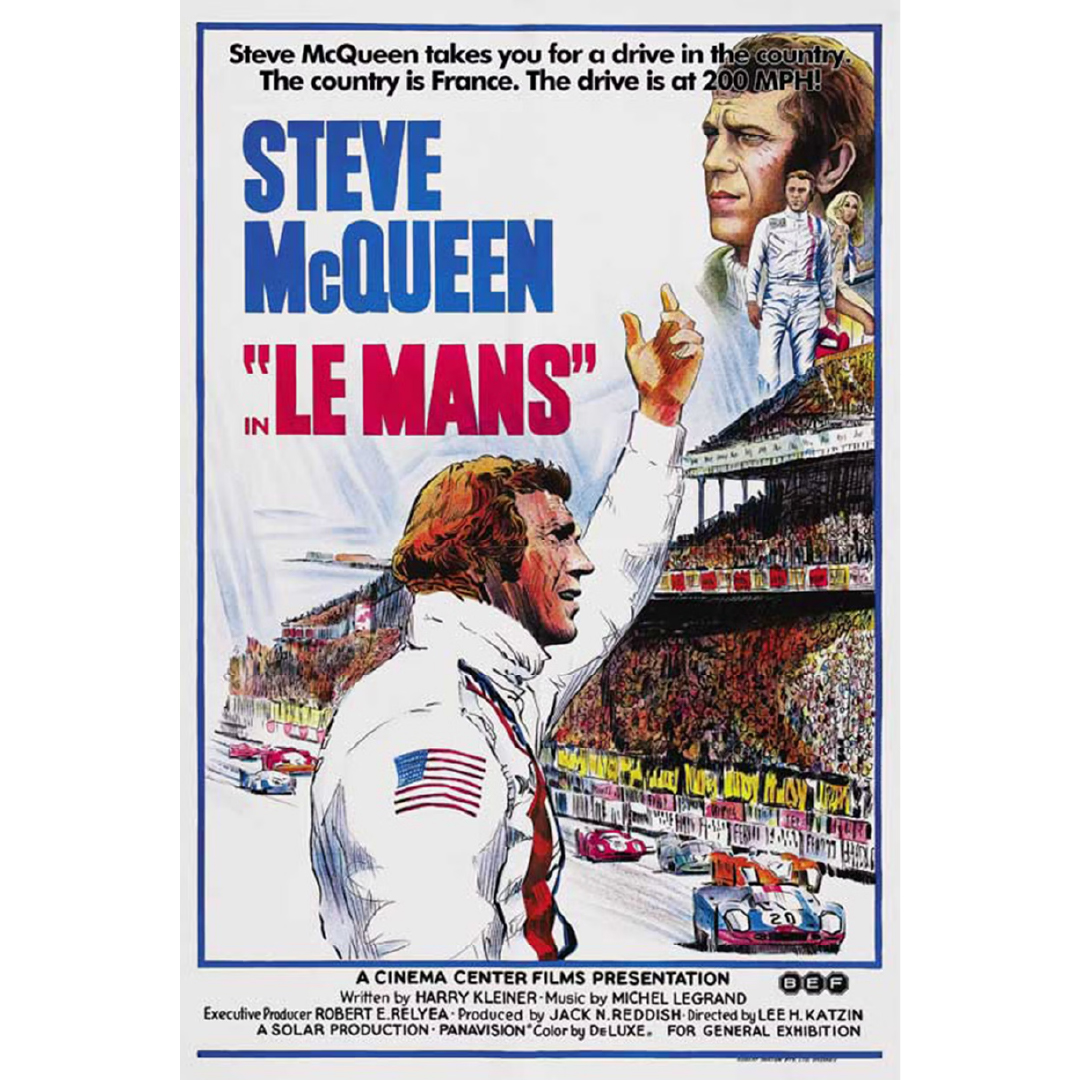
Beyond its mechanics, the Monaco’s design language was strikingly modern — luminous hands, applied indices, and a domed crystal enhancing both legibility and presence. The Monaco was also the first square automatic chronograph with water resistance, proving that avant-garde design and mechanical sophistication could coexist. Its status as a cultural icon was cemented when Steve McQueen wore it in Le Mans (1971), making it forever linked to motorsport and cinema.

Heuer Monaco, reference 74033, circa 1972
Over the decades, the Monaco evolved while staying true to Jack Heuer’s daring design. The original Monaco 1133B retained the classic blue dial with Calibre 11, while the 1970s Monaco 74033 introduced the simplified Calibre 15 two-register layout.
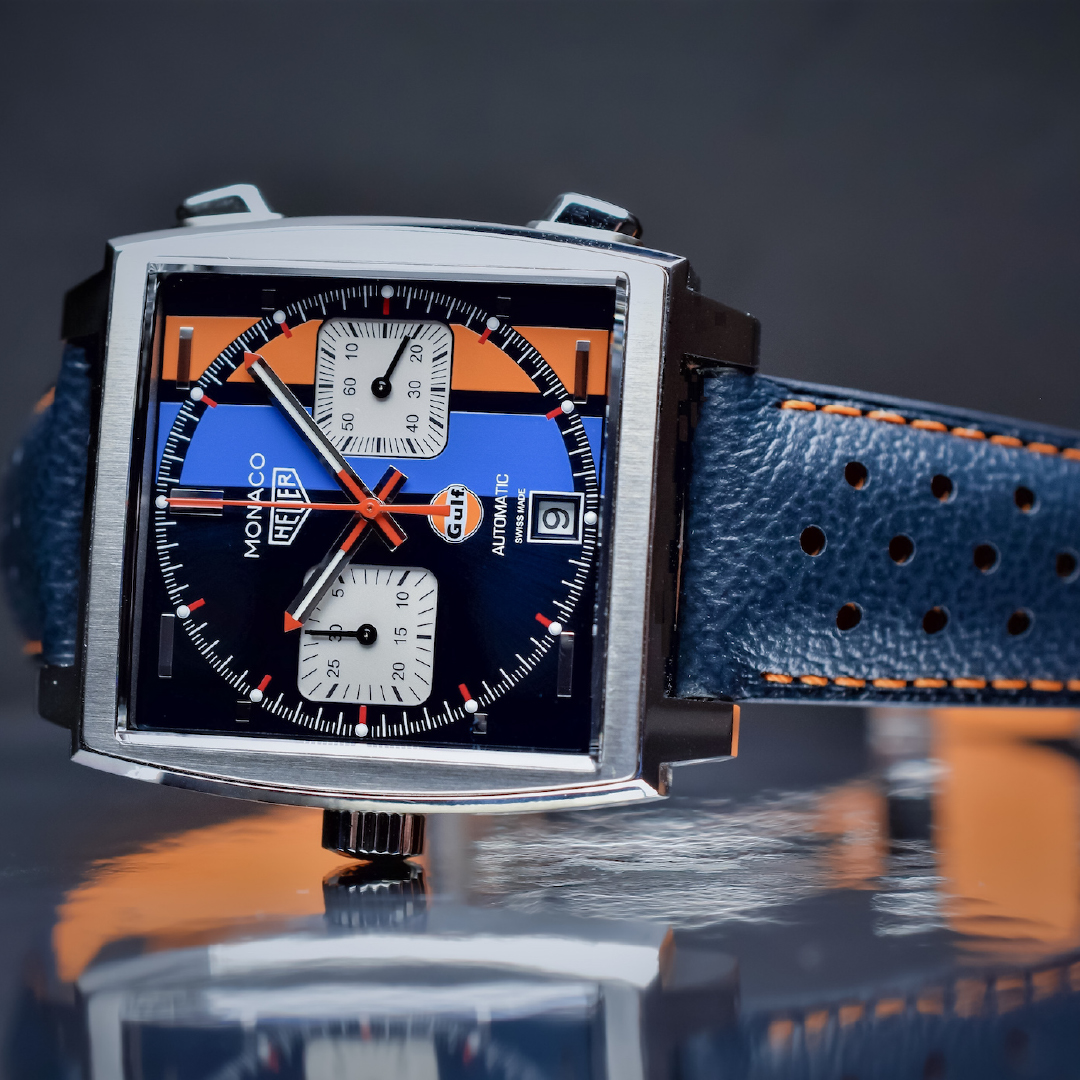
TAG Heuer Monaco Gulf Special Edition, Reference CAW211R.FC6401, 2018
Gulf Special Editions brought motorsport-inspired colorways, while the 2019 Monaco Heuer 02 introduced the in-house column-wheel chronograph and 80-hour power reserve.
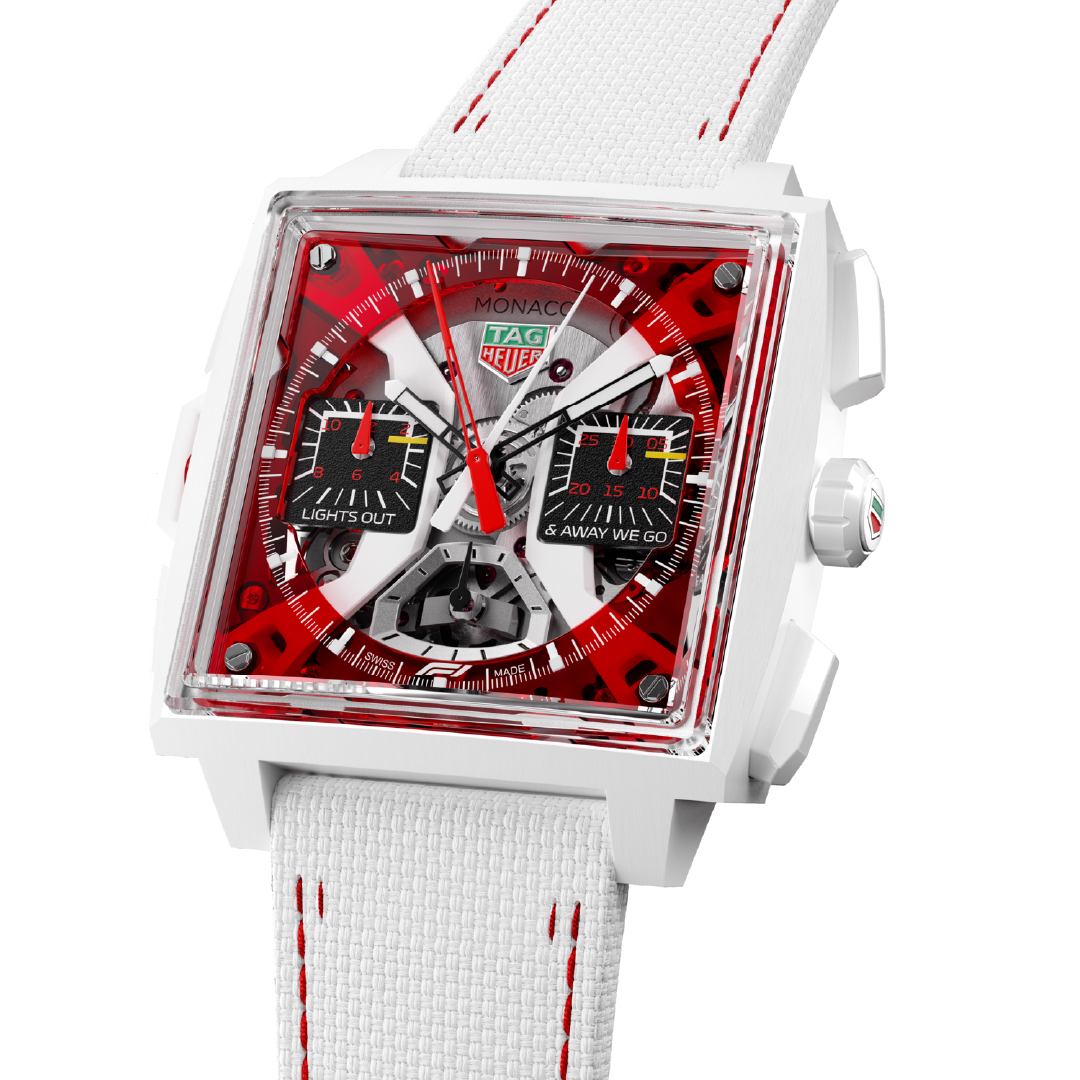
TAG Heuer Monaco Split Seconds Chronograph F1; Ceramic Reference CBW2190.FC8356
In 2025, the collection expanded with the Monaco Chronograph x Gulf, the limited Split-Seconds Chronograph F1, the DLC-coated Monaco Chronograph Stopwatch, and the ultra-modern Flyback Chronograph TH-Carbonspring, blending heritage with cutting-edge mechanical innovation.The Calibre 11’s modular architecture enabled the iconic square design without compromising automatic functionality.
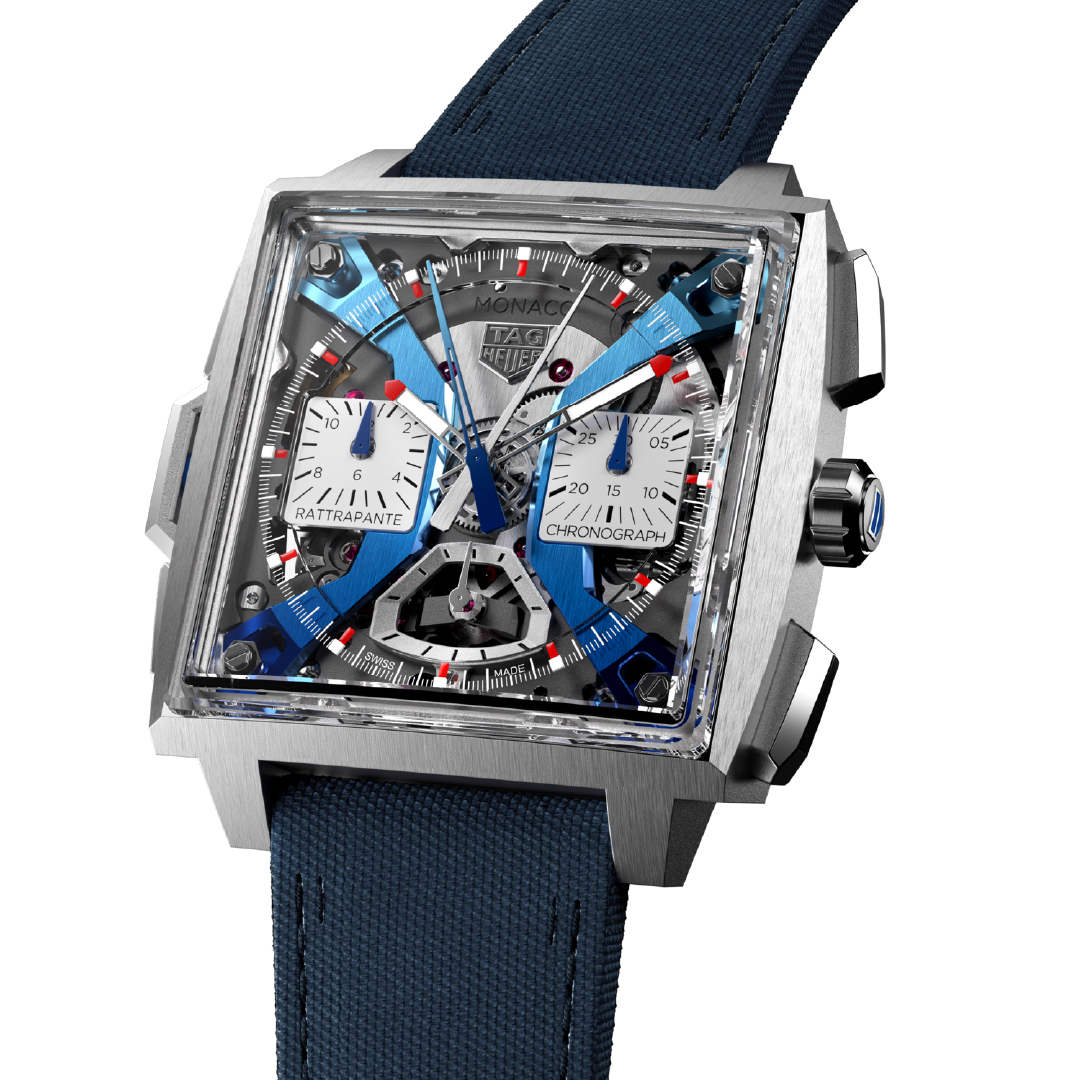
TAG Heuer Monaco Split Seconds Chronograph F1; Titanium Reference CBW2162.FC8339
1970s – Ferrari, Formula 1, and Jack Heuer’s Racing Vision
Motorsport’s modern identity owes much to Jack Heuer’s daring foresight. His visionary approach to racing partnerships redefined how brands connected with speed, precision, and prestige. Beginning with his groundbreaking collaboration with Ferrari in 1971, and later forging legendary alliances with McLaren (1986-2015), Jack Heuer’s influence helped redefine racing’s golden age. His leadership also brought TAG Heuer to the forefront as the Official Timekeeper of Formula 1 from 1992 to 2003, laying the foundation for partnerships that continue to inspire and innovate today.
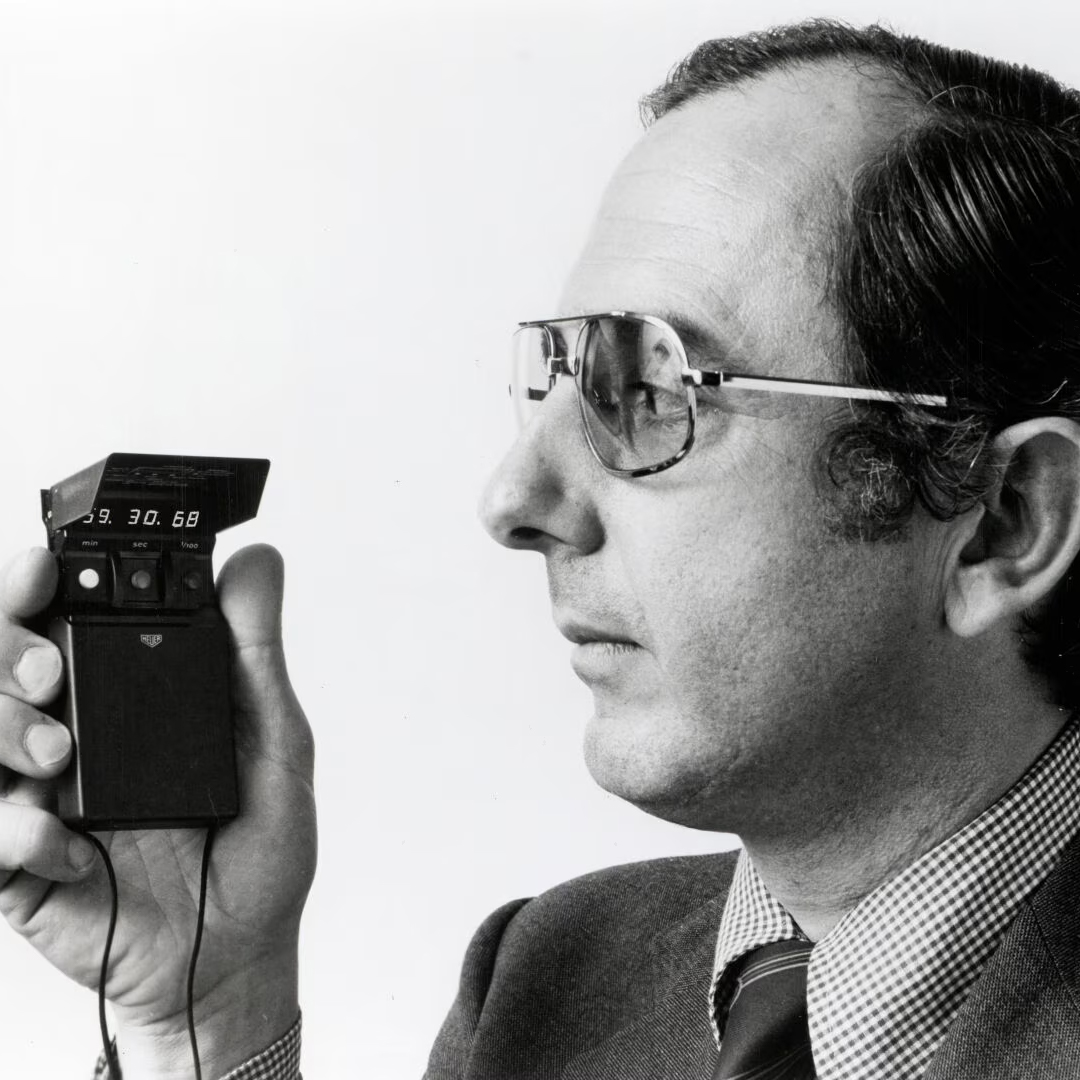
Timepieces such as the Autavia and Monaco were engineered for precision and endurance, with robust cases, highly legible dials, and chronograph functions calibrated for split-second timing. Jack also oversaw the creation of specialized instruments like the Centigraph Le Mans, capable of measuring 1/1000th of a second.

Jack Heuer meeting Enzo Ferrari
This racing heritage continues today in the TAG Heuer Formula 1 collection, including Red Bull Racing Editions and modern F1 chronographs, keeping Jack’s vision of motorsport-inspired precision alive.
Jack Heuer’s story isn’t just about watches; it’s about timing — both literal and cultural. He anticipated the rise of motorsport as a global spectacle. He recognized the power of partnerships long before “brand ambassador” became industry jargon. And he understood that good design is not about decoration but about clarity, proportion, and restraint.
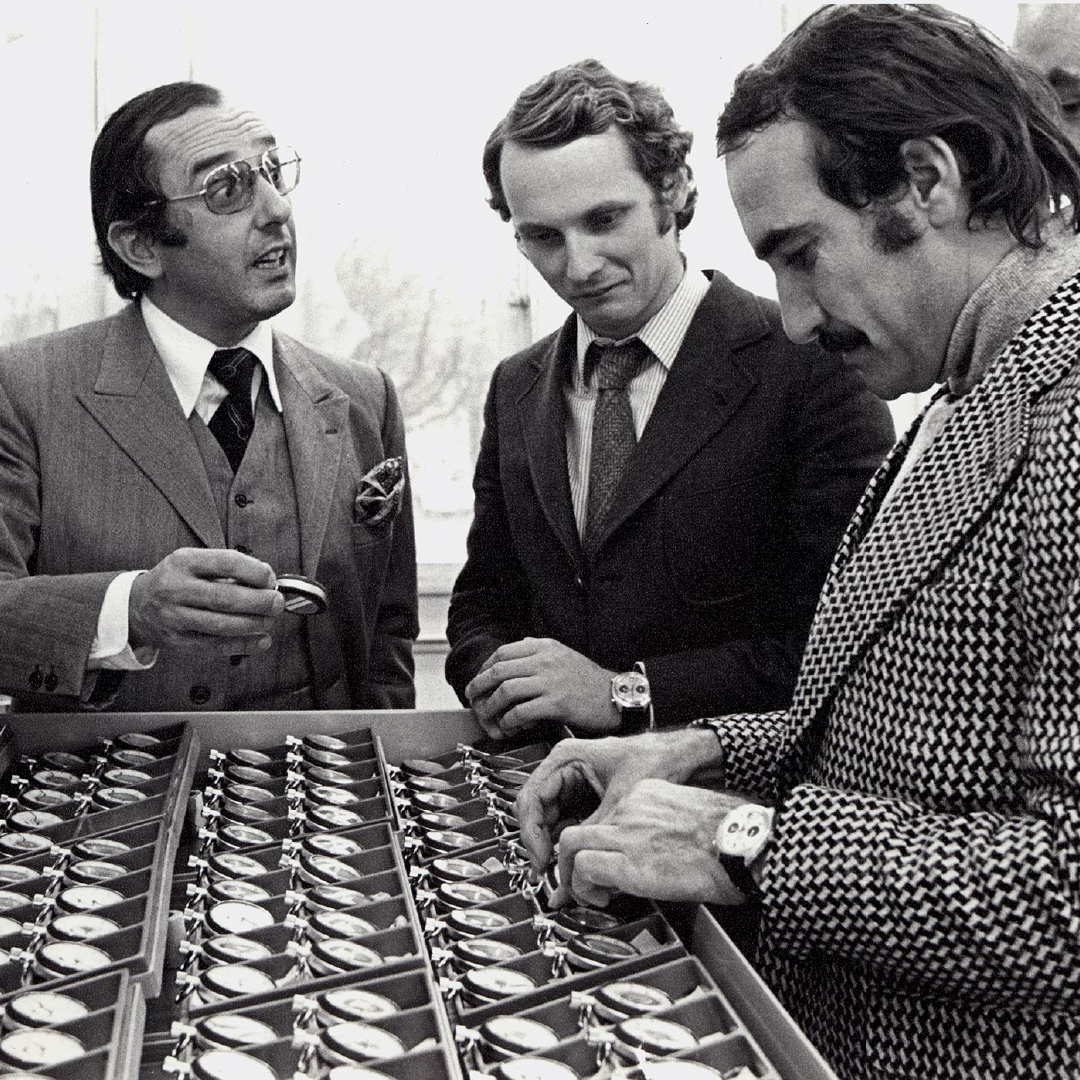
Jack Heuer with Niki Lauda
To call him a “living legend” is not to indulge in marketing language but to acknowledge his unusual position: few individuals in watchmaking have left such a visible and lasting imprint. The Carrera, the Monaco, the Autavia — these are not just products but chapters of modern design history. For his 80th birthday in 2012, the brand released a Carrera bearing his name, a tribute to a designer witnessing his creation evolve and remain coveted across half a century.
Even today, Jack Heuer’s influence is felt every time a driver straps on a chronograph or a collector admires the clean lines of a Carrera dial. His vision reshaped how we experience time, speed, and style — a legacy of precision, innovation, and daring design. As he once said,
“Time never stops, why should we?”
%20(1).jpeg)
%20(1).jpeg)
Every once in a while, a designer comes along who doesn’t just make products — he shapes an era. Jack Heuer is that designer for the world of watches.
A century after the company was founded by his great-grandfather, Jack Heuer’s vision carried the family name beyond Switzerland’s borders and onto the wrists of drivers, collectors, and film stars. His instinct for design and his appetite for the new ensured that Heuer — later TAG Heuer — became more than a watch brand; it became a cultural symbol.

Jack Heuer understood what few did — that a watch isn’t merely a tool to measure time, but a way to feel it. Every watch he designed pushed boundaries in form and function, yet remained unmistakably Heuer. His introduction of modular construction, microrotor architecture, and racing-inspired ergonomics redefined how watches interacted with their wearers.
To collectors today, that balance between daring and discipline defines not just the man, but the legend.
1962 – Autavia: The Beginning of a New Era
When Jack Heuer took charge of the company at the age of 29, his first mission was to modernize its image. The result was the Autavia, the first wrist chronograph designed entirely under his leadership.

Originally a dashboard timer used in rally cars and aircraft, the 1962 wrist version featured a stainless steel 39mm case, a rotating aluminum bezel available in 12-hour, minute, or tachymeter scales, and the Valjoux 72 hand-wound chronograph movement beating at 18,000 vibrations per hour. Its large luminous dauphine hands, contrasting sub-dials, and highly legible black-and-white layout gave it the functionality racers demanded.

Heuer Carrera, Reference 2446, circa 1962
As described by Jack Heuer in his autobiography,
“In the autumn of 1961 I decided with my production team to create a new “Autavia” as a wrist chronograph. Until then we had never added a turning bezel to one of our wrist chronographs. We therefore designed this new “Autavia” to have a turning black bezel with a choice of division markers. A bezel with 60 separate one-minute divisions, for example, would allow the wearer to set a marker for a defined interval of less than one hour; a 12-hour division would allow the time in another time zone to be displayed; and divisions of 1/100th of a minute would be useful for time study purposes.”
The case uses a screw-back construction, with the back marked with the “Heuer” shield and “Autavia” name, as well as “Waterproof – Guaranteed 330 Feet Under Water”.

The first generation of the Autavia chronograph (1962 through 1967) used round, screw-back cases, with manual winding movements. The second generation (1967 through 1972) used a snap-back case referred to as a “compressor” case, with manual winding movements. The third generation of Autavia chronographs (1969 through 1983) used C-shape cases, with a variety of automatic and manual winding movements.

Heuer Autavia, Reference 1163T, circa 1972
The Autavia wasn’t just a new watch — it was a statement that Heuer would lead the age of motor sport timing.
1963 – Carrera: The Chronograph as Art
The story of the TAG Heuer Carrera is inseparable from the legacy of TAG Heuer itself.

Heuer Carrera, Reference 2447S, circa 1963
Even its origin has an iconic story. It all began in 1962, when Jack Heuer attended the 12 Hours of Sebring in Florida. There, he heard talk of the Carrera Panamericana — a legendary and perilous Mexican road race from the 1950s. The name Carrera, meaning “race” in Spanish, struck him instantly — elegant, dynamic, and full of spirit. When he returned to Switzerland, he wasted no time registering the name Heuer Carrera. The rest, as they say, is history.
Decades later, Heuer would share his thoughts on the Carrera name in his autobiography.
“I loved not only its sexy sound but also its multiple meanings – which include road, race, course and career. All very much Heuer territory.”

Jack Heuer with his father Charles Edouard Heuer
Powered initially by the Valjoux 72 and later the Valjoux 92, the Carrera featured a 36mm polished stainless-steel case, a flat silver or panda dial, and a clean tri-compax layout free of tachymeter clutter. Its inner tension ring, set at a 45° angle, not only increased structural rigidity but served as a perfect platform for a sharply printed seconds scale — improving legibility under race conditions. The double-step bezel, faceted lugs, and sunray-brushed dial finish gave it visual precision to match its mechanical reliability.
As Heuer once declared,
‘The Carrera exudes modernity and elegance thanks to its clean, ultra-legible design. This timeless style, as well as its bold and daring spirit, have been the keys to its longevity’.
In the decades since the TAG Heuer Carrera has evolved into a vast collection featuring an expansive variety of functions, movements, materials, and designs.

Heuer Skipper 7754, circa 1968
In 1968, Heuer introduced the Skipper, a colorful yachting chronograph with a 15-minute regatta countdown, celebrating the brand’s involvement with the America’s Cup.

Heuer Carrera Chronomatic, Reference 1153N
By 1969, the first automatic Carrera arrived, powered by the revolutionary modular Calibre 11, combining self-winding mechanics with Jack Heuer’s minimalist dial philosophy. The modular design reduced movement thickness while maintaining automatic winding efficiency, enabling the Carrera to retain its slim, elegant profile.
The Carrera was reinvigorated in 1996 with a reissue that appealed to collectors, followed in 2012 by the Mikrogirder, a gravity-defying mechanical chronograph, achieving a staggering 7,200,000 vibrations per hour, unprecedented in mechanical watchmaking, accurate to 5/10,000th of a second.

TAG Heuer Carrera 160 Years Anniversary Limited Edition, Reference CBK221B.FC6479
Most recently, the 2020 160th Anniversary Carrera Sport Chronograph and Silver Edition showcased the in-house Calibre Heuer 02, blending heritage design cues with contemporary watchmaking technology.
1969 – Monaco: The Shape of Modern Time
In March 1969, Heuer unveiled the Monaco reference 1133 as part of the coordinated launch of the Calibre 11 automatic chronograph. Calibre 11 was the result of Project 99, a joint venture with Breitling, Büren, and Dubois Dépraz, which produced the self-winding chronograph just months after Zenith’s El Primero.
With its radical square case and bright blue dial, the Monaco was unlike anything else on the market.

Heuer Monaco, Reference 1133B, circa 1969
With its bold 39 mm square case, sharply cut lines, and a play of brushed and polished finishes, the Monaco made an immediate statement at Basel in 1969. The unconventional left-hand crown subtly signaled a new era — manual winding was no longer necessary. Inside, the watch housed the revolutionary Calibre 11 automatic chronograph, one of the world’s first modular self-winding movements, marrying Büren’s 1282 microrotor base with a Dubois Dépraz chronograph module. Beating at 19,800 vph and offering a 42-hour power reserve, it balanced innovation with performance.

Beyond its mechanics, the Monaco’s design language was strikingly modern — luminous hands, applied indices, and a domed crystal enhancing both legibility and presence. The Monaco was also the first square automatic chronograph with water resistance, proving that avant-garde design and mechanical sophistication could coexist. Its status as a cultural icon was cemented when Steve McQueen wore it in Le Mans (1971), making it forever linked to motorsport and cinema.

Heuer Monaco, reference 74033, circa 1972
Over the decades, the Monaco evolved while staying true to Jack Heuer’s daring design. The original Monaco 1133B retained the classic blue dial with Calibre 11, while the 1970s Monaco 74033 introduced the simplified Calibre 15 two-register layout.

TAG Heuer Monaco Gulf Special Edition, Reference CAW211R.FC6401, 2018
Gulf Special Editions brought motorsport-inspired colorways, while the 2019 Monaco Heuer 02 introduced the in-house column-wheel chronograph and 80-hour power reserve.

TAG Heuer Monaco Split Seconds Chronograph F1; Ceramic Reference CBW2190.FC8356
In 2025, the collection expanded with the Monaco Chronograph x Gulf, the limited Split-Seconds Chronograph F1, the DLC-coated Monaco Chronograph Stopwatch, and the ultra-modern Flyback Chronograph TH-Carbonspring, blending heritage with cutting-edge mechanical innovation.The Calibre 11’s modular architecture enabled the iconic square design without compromising automatic functionality.

TAG Heuer Monaco Split Seconds Chronograph F1; Titanium Reference CBW2162.FC8339
1970s – Ferrari, Formula 1, and Jack Heuer’s Racing Vision
Motorsport’s modern identity owes much to Jack Heuer’s daring foresight. His visionary approach to racing partnerships redefined how brands connected with speed, precision, and prestige. Beginning with his groundbreaking collaboration with Ferrari in 1971, and later forging legendary alliances with McLaren (1986-2015), Jack Heuer’s influence helped redefine racing’s golden age. His leadership also brought TAG Heuer to the forefront as the Official Timekeeper of Formula 1 from 1992 to 2003, laying the foundation for partnerships that continue to inspire and innovate today.

Timepieces such as the Autavia and Monaco were engineered for precision and endurance, with robust cases, highly legible dials, and chronograph functions calibrated for split-second timing. Jack also oversaw the creation of specialized instruments like the Centigraph Le Mans, capable of measuring 1/1000th of a second.

Jack Heuer meeting Enzo Ferrari
This racing heritage continues today in the TAG Heuer Formula 1 collection, including Red Bull Racing Editions and modern F1 chronographs, keeping Jack’s vision of motorsport-inspired precision alive.
Jack Heuer’s story isn’t just about watches; it’s about timing — both literal and cultural. He anticipated the rise of motorsport as a global spectacle. He recognized the power of partnerships long before “brand ambassador” became industry jargon. And he understood that good design is not about decoration but about clarity, proportion, and restraint.

Jack Heuer with Niki Lauda
To call him a “living legend” is not to indulge in marketing language but to acknowledge his unusual position: few individuals in watchmaking have left such a visible and lasting imprint. The Carrera, the Monaco, the Autavia — these are not just products but chapters of modern design history. For his 80th birthday in 2012, the brand released a Carrera bearing his name, a tribute to a designer witnessing his creation evolve and remain coveted across half a century.
Even today, Jack Heuer’s influence is felt every time a driver straps on a chronograph or a collector admires the clean lines of a Carrera dial. His vision reshaped how we experience time, speed, and style — a legacy of precision, innovation, and daring design. As he once said,
“Time never stops, why should we?”








